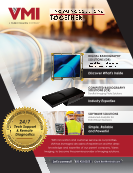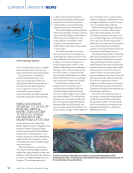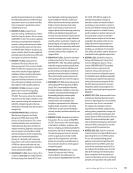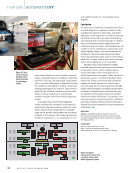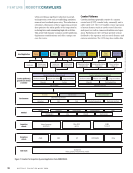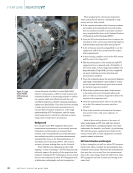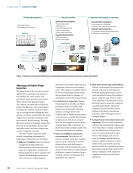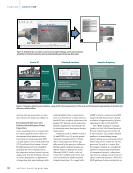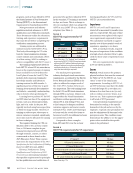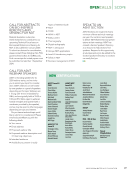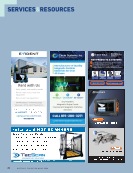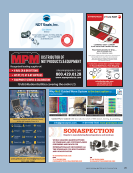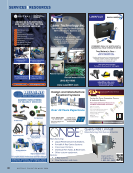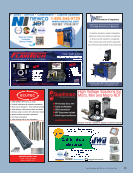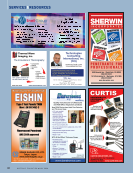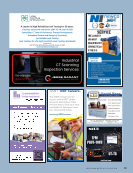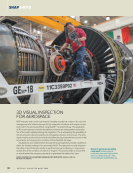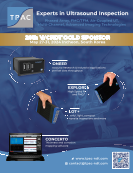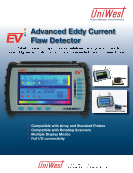Written. Written exams are used to
assess a candidate’s understanding of the
subject matter contained in the appro-
priate syllabus or outlined requirements.
SNT-TC-1A and CP-189 both refer to the
training outlines in CP-105 for theory. The
topics of the questions contained in the
general examination are found there. The
number of general questions ranges from
30 (minimum) to typically 50 on the basic
principles and theory applicable to the
VT method. The number of specific ques-
tions is determined by the codes, specifi-
cations, and procedures applicable to the
inspections mandated by customer speci-
fications, which the inspector must adhere
to during their work for the employer.
Practical. A demonstration of practical
proficiency is called the practical exam.
The primary requirement is to follow a
10-point checklist, though specific details
of the checklist are not explicitly provided.
Table 5 shows a typical example of
a practical exam’s 10-point checklist.
Each item on the list carries a value of
10 points. A minimum score of 70% is
required to pass.
When each of the 10 checklist points
carries equal weight at 10 points each,
failing the practical exam becomes
unlikely. Generally, with this scoring
system, most candidates score 90% or
higher, resulting in a pass.
An alternate is a checklist like shown
in Table 6. In this scenario, mandatory
elements must be successfully com-
pleted with a score of 80% or higher,
otherwise the entire practical exam is
considered failed. Performance, evalu-
ation, and disposition should be man-
datory checklist items where a pass
or fail decision is required. The points
assigned to other listed items can be
discretionary.
The technique and order of conduct-
ing a practical proficiency demonstration
T A B L E 5
Typical practical exam checklist
example
Observation
item Unsatisfactory Satisfactory
1. Surface
condition
2. Procedure
compliance
3. Equipment
usage
4. Adequate
coverage
5. Attribute
identification
6.
Discontinuity/
attribute
evaluation
7. Disposition
and evaluate
discontinuity/
attributes
8. Report/
document
results
9. Comply
with safety
cautions
10. Health
T A B L E 6
Proposed example of 10-point checklist for VT practical exam Level II (VT or RVI)
Categories Point weight
1. Procedure selection 3
2. Surface preparation/cleanliness 2
3. Method application—satisfactory technique 10
4. Equipment and material selection 10 (min 8 pts req’d)
• Equipment
• Material (cleaning pre and post)
5. Adequate area of interest coverage 10
6. Interpretation of indications and disposition 40 (min 32 pts req’d)
• Complete coverage for interpretation
• Determination of relevance
• Appropriate application of acceptance criteria
• Appropriate disposition of part, component, or system (min 80% accurate)
7. Standard practice codes or procedure usage 10
• Familiarity
• Compliance
8. Records 10
• Completeness
• Appropriate data entry
• Control of records
• Compliance with routing requirements
9. Health factors 3
• Site procedures familiarity
• Adherence
• Compliance
10. Safety factors 2
• Volatile liquids
• Electrical hazards
• Light and infrared radiation
80% min required total and for Sections 4 and 6 as noted 100 pts possible
J U L Y 2 0 2 4 • M A T E R I A L S E V A L U A T I O N 59
assess a candidate’s understanding of the
subject matter contained in the appro-
priate syllabus or outlined requirements.
SNT-TC-1A and CP-189 both refer to the
training outlines in CP-105 for theory. The
topics of the questions contained in the
general examination are found there. The
number of general questions ranges from
30 (minimum) to typically 50 on the basic
principles and theory applicable to the
VT method. The number of specific ques-
tions is determined by the codes, specifi-
cations, and procedures applicable to the
inspections mandated by customer speci-
fications, which the inspector must adhere
to during their work for the employer.
Practical. A demonstration of practical
proficiency is called the practical exam.
The primary requirement is to follow a
10-point checklist, though specific details
of the checklist are not explicitly provided.
Table 5 shows a typical example of
a practical exam’s 10-point checklist.
Each item on the list carries a value of
10 points. A minimum score of 70% is
required to pass.
When each of the 10 checklist points
carries equal weight at 10 points each,
failing the practical exam becomes
unlikely. Generally, with this scoring
system, most candidates score 90% or
higher, resulting in a pass.
An alternate is a checklist like shown
in Table 6. In this scenario, mandatory
elements must be successfully com-
pleted with a score of 80% or higher,
otherwise the entire practical exam is
considered failed. Performance, evalu-
ation, and disposition should be man-
datory checklist items where a pass
or fail decision is required. The points
assigned to other listed items can be
discretionary.
The technique and order of conduct-
ing a practical proficiency demonstration
T A B L E 5
Typical practical exam checklist
example
Observation
item Unsatisfactory Satisfactory
1. Surface
condition
2. Procedure
compliance
3. Equipment
usage
4. Adequate
coverage
5. Attribute
identification
6.
Discontinuity/
attribute
evaluation
7. Disposition
and evaluate
discontinuity/
attributes
8. Report/
document
results
9. Comply
with safety
cautions
10. Health
T A B L E 6
Proposed example of 10-point checklist for VT practical exam Level II (VT or RVI)
Categories Point weight
1. Procedure selection 3
2. Surface preparation/cleanliness 2
3. Method application—satisfactory technique 10
4. Equipment and material selection 10 (min 8 pts req’d)
• Equipment
• Material (cleaning pre and post)
5. Adequate area of interest coverage 10
6. Interpretation of indications and disposition 40 (min 32 pts req’d)
• Complete coverage for interpretation
• Determination of relevance
• Appropriate application of acceptance criteria
• Appropriate disposition of part, component, or system (min 80% accurate)
7. Standard practice codes or procedure usage 10
• Familiarity
• Compliance
8. Records 10
• Completeness
• Appropriate data entry
• Control of records
• Compliance with routing requirements
9. Health factors 3
• Site procedures familiarity
• Adherence
• Compliance
10. Safety factors 2
• Volatile liquids
• Electrical hazards
• Light and infrared radiation
80% min required total and for Sections 4 and 6 as noted 100 pts possible
J U L Y 2 0 2 4 • M A T E R I A L S E V A L U A T I O N 59





